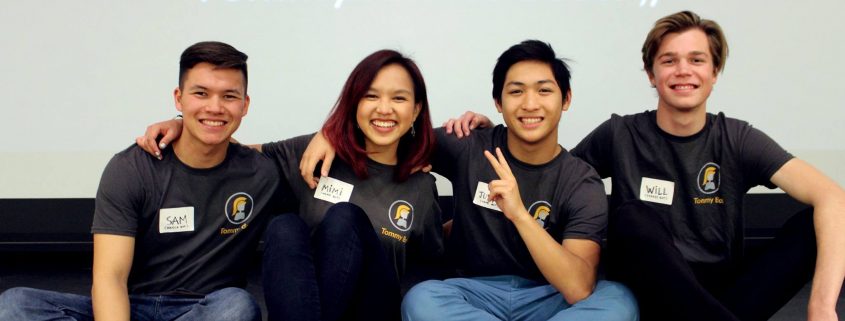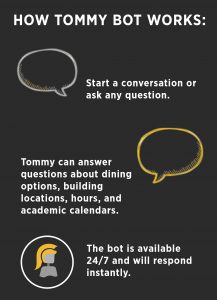Got a question? Ask Tommy Bot, USC’s first ever chatbot
It is a confidently stated slogan, followed by a sly wink emoticon comprised of a semicolon and a parenthetical.
“Tommy knows best,” the slogan says, foreshadowing the omnisciently reliant innovation that is Tommy Bot, an online chatbot Trojans can depend on every minute of their day.
A 24-hour accessible innovation that replies within seconds of receiving a message, Tommy Bot has a rapid answering mechanism disguised behind a simple golden silhouette of USC’s figurehead: Tommy Trojan. Tommy Bot will be the University’s first campus chatbot, operating through Facebook Messenger to serve as a knowledgeable virtual assistant.
The creators of Tommy Bot originally envisioned this chatbot as a tool that could easily answer basic questions about the University, such as the hours of its dining halls, libraries or buildings. These primary functions have evolved over the past few months; Tommy Bot has progressed into a rapidly expanding project with community-driven roots. And for its creators, it contains the potential to develop into something much greater.
The journey behind Tommy Bot began in September within one of USC’s established entrepreneurial student organizations, LavaLab. Proclaiming itself as USC’s “project incubator,” the organization promotes and provides resources for designers, developers and entrepreneurs by encouraging student-run projects.
The four creators of Tommy Bot — Sam Breck, Justin He, Will Durkee and Mimi Tran Zambetti — teamed up through the program and were assigned a set of ideas to guide their progress.
The goal was to create a product for LavaLab’s Demo Night, an event last November in which various teams pitched their product ideas to industry professionals.
“We were initially placed into industries, or categories, that would help guide the project,” He, one of the coders of the bot, said.
The creators were confronted with a diverse range of topics to choose from. They could create a product that catered to campus issues or one marketed to a global audience.
Breck, He and Durkee are coders and computer science majors, while Tran Zambetti’s background is more design-focused. After much thought, the students settled on the origins of Tommy Bot, and the team sought to produce an interactive, user-friendly innovation for the campus body.
While creating — and essentially coding — Tommy Bot, the four divvied up the tasks, with the coders working on their individual segments and Tran Zambetti focusing more on design and marketing the product.
The team realized that online access to university-related information was inefficient, requiring students to browse a number of USC-affiliated websites to find the information they needed. They aimed to create and market an application that is direct — a single-handed resource that contains a bulk of information about the campus.
“As we developed this bot to help our fellow students, we tried to get as much feedback as possible,” Breck said. “Through this process, we managed to create a new method of interacting with USC-related information.”
Originally, the creators’ vision of Tommy Bot was very limited in scope, similar to a basic directory that compiled the hours and locations of USC’s campus. However, as the bot is garnering more attention and student use, the team is continually adding features to the application’s code.
“In beta mode, we had about 200 users, and at the bot’s peak, we answered about 500 queries per day,” He said, in response to Tommy Bot’s usage statistics.
Over winter break, the developers fine-tuned the bot by debugging it and creating unique features, such as adding the ability to book a room in Leavey Library, implementing campus calendar events and answering detailed questions about dining hall menus.
Currently, its code is open-sourced, meaning that any member of the public can contribute or suggest features that may help the coders innovate. Regardless, new features are constantly being made to refine the application, and the creators hope that the open-sourced code fosters a sense of community within the product, which is unique to USC.
In the coming week, Tommy Bot’s creators are preparing to officially launch at the start of the spring semester, with the intent of marketing the bot toward spring admits who are new to campus.
“It was extremely gratifying to see friends and other students start to solve some of their day-to-day problems through Tommy,” Durkee said.
Yet, the team still has greater things in mind for Tommy Bot outside of the campus community.
“We hope to expand the product’s chatbot concept to other universities, especially those with large campuses, and engage in events that will reach out to local coding communities,” He said.
Tommy Bot can be accessed through Facebook, and for more information and updates, visit www.tommybot.com or follow Tommy on Instagram @tommy.bot.


